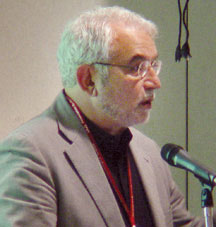More Than Meets the Eye

Gün Semin
Want someone to like you? Here’s a hint: Crank up the temperature in the room. While most human emotional expressions are communicated via facial expressions and body language, research presented during the symposium “More Than Meets the Eye: Hidden Signals and Social Communication” shows that in addition to verbal and nonverbal visual information, touch, temperature, and olfaction have been found to affect social communication among humans.
Body odor is something Denise Chen, Rice University, is very familiar with. No, she doesn’t smell, but she is interested in studying the relationship between chemosensation from body odors and social behavior on both behavioral and neural levels. Chen explained that “olfaction is an important system, not only for detecting food, but also for detecting the fine nuances in human social behavior.” While animals rely on chemosensory communication to elicit sexual interest or reproductive and emotional states, humans have been thought to rely mostly on language and facial expressions to communicate our emotions. Now Chen has shown that chemosignals generated by people experiencing emotions such as fear and sexual arousal have a significant effect on their behavior and brain activations. Her findings imply that humans too utilize chemosensory cues in their affective communications.
In addition to body odors, environmental odors can foster social communication, for example, between parent and child. Monique Smeets, Utrecht University, Netherlands, pulled out a bottle of baby powder and passed it around the room. Smeets explained that baby powder scents can provoke tender feelings in parents, reminding them of when their children were babies. She called this the “baby powder effect” and was able to recreate this experience in the lab by pairing a novel smell that strongly resembled common baby powder with child rearing. Smeets found that fragrances associated with nurturing gave rise to nurturing behavior, providing support for the common belief that baby powder scent can promote infant nurturing behavior and enhance the bond between parent and child. This effect is so strong that Smeets suggests using these odors during teen-pregnancy courses to enhance care-giving behaviors when the baby arrives.
During his PhD at the University of Cambridge, George Christopoulos identified the behavioral and neural components involved in human decision making under risk. In particular, he identified neural signatures predicting more or less risk-averse choices. His current research at King Casas’ Laboratory for Interpersonal Decision Neuroscience at Baylor College of Medicine further explores the social aspects of decision making and also tries to identify biomarkers associated with decision irregularities and social behavioral abnormalities in clinical populations. To achieve this, he investigates basic social phenomena under the social neuroscience prism of decision and game theory using computational approaches and neuroimaging methods.
APS Fellow Gün Semin, Utrecht University, Netherlands, a renowned researcher in the field of embodied cognition, provided more evidence that physical features of the environment, such as temperature, distance, and smell, play a prominent role in forming impressions of others. In one experiment, Semin found that if you rate a person as friendly or warm, you will also perceive the temperature in the room as warmer. Semin stressed that features of our environment should not be neglected in social psychology experiments. He believes that in order to paint a full picture of how we interact with others, we must understand the crucial role physical features of the environment have on social communication. “I think this is a very new way of looking at social cognition research,” said Semin.





APS regularly opens certain online articles for discussion on our website. Effective February 2021, you must be a logged-in APS member to post comments. By posting a comment, you agree to our Community Guidelines and the display of your profile information, including your name and affiliation. Any opinions, findings, conclusions, or recommendations present in article comments are those of the writers and do not necessarily reflect the views of APS or the article’s author. For more information, please see our Community Guidelines.
Please login with your APS account to comment.